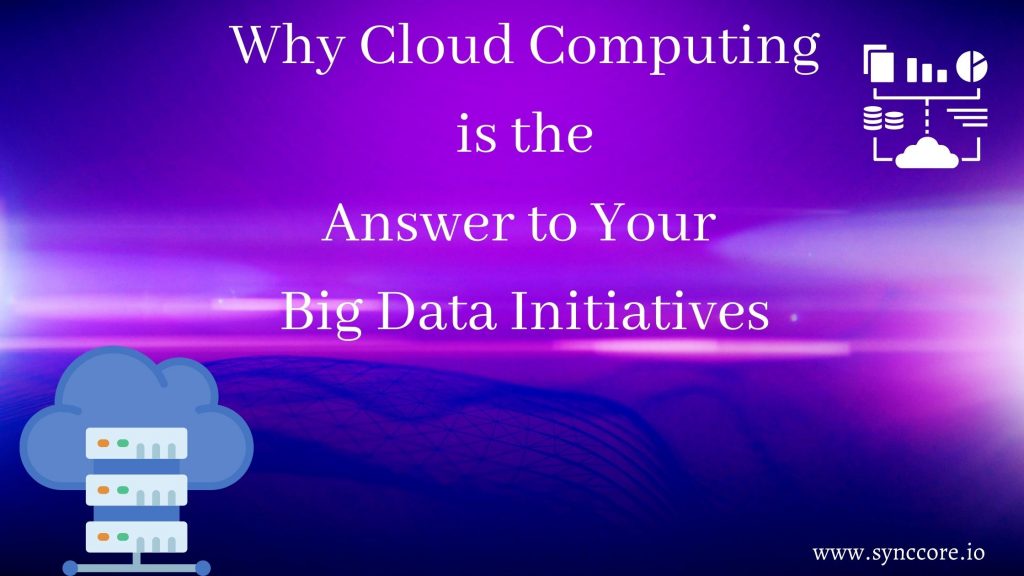Table of Contents
Why Cloud Computing is the Answer to Your Big Data Initiatives
The cloud can assist you in processing and analyzing large amounts of data more quickly, resulting in insights that can help you enhance your products and business.
Thanks to technological advancements, companies can now profit from streamlined processes and cost-effective operations. However, the availability of data from any source imaginable – social media, sensors, business apps, and so on – has become a game-changer for firms of all kinds.
Big data refers to the vast amounts of data that corporations are bombarded with daily. Many people have heard of it, and many people want to use it to help their business grow, but only a few people have genuinely succeeded in doing so.
Simultaneously, businesses have embraced cloud computing to improve their IT operations and quickly produce better software.
Combining big data and cloud computing is a potent combo that has the potential to alter your business.
The basic properties of big data are discussed in this essay, as well as a case for storing your data in the cloud. We also go over the benefits and drawbacks of such a shift to help you plan for your big data relocation. Let’s get started!

What is big data?
Big data, according to Gartner, is defined as high-volume, high-velocity, and high-variety information assets that necessitate cost-effective, creative types of data processing to enable improved insight, decision-making, and process automation.
That’s quite a mouthful.
The concept of big data and everything it entails can be better comprehended with four Vs., based on Gartner’s definition:
Volume: Regularly, private corporations, government agencies, and other organizations amass enormous amounts of data. As a result, big data’s distinguishing attribute is volume.
Velocity: It’s a fact that data may and will accumulate quickly. But it’s the speed with which you can process and examine this data to turn it into meaningful information that matters.
Variety: The sorts of information gathered might be pretty varied. Both structured and unstructured data, including tweets, emails, photos, videos, and other forms of media, must be consumed and processed.
Veracity: Big data can contain a lot of noise due to its size and diversity. Thus, integrity relates to the data’s certainty, as well as how your big data tools and analytical techniques can distinguish between low-quality data and data that is critical to your organization.
A fifth V — value – is also mentioned by technology executives. However, this one isn’t inherent in the massive amounts of raw data. Instead, the actual value of big data can only be achieved when the correct data is collected and processed to get actionable insights.
Let’s look at some data to get a better idea of how important big data is:
- Every day, over 1 billion Google searches and 294 billion emails are sent.
- 65,972 Instagram photographs are uploaded per minute, 448,800 tweets are sent, and 500 hours of YouTube videos are uploaded.
- The number of smartphone users is expected to reach 6.1 billion by 2020. The Internet of Things (IoT) could have grown to 26 billion connected gadgets by that time.
For sure, big data is enormous.
Big data and the cloud – a match made in heaven?
Typically, big data projects begin with data storage and basic analytics modules. However, as you figure out how to collect data on a grander scale, you’ll need to figure out better ways to handle and analyze it, which will almost certainly necessitate infrastructure upgrades.
To meet the rapidly-increasing analytics requirements, you might expand your in-house data warehouse or add more servers. However, even with the help of your on-premise systems, your infrastructure may not be able to keep up in the long run.
This is where the cloud comes into play, or, to put it another way when your massive data is moved to the cloud.
Why big data in the cloud makes perfect sense
The advantages of migrating to the cloud are widely known. However, these advantages become much more critical for big data analytics.
Big data entails handling petabytes (and, perhaps, exabytes and zettabytes) of data, and the cloud’s scalable environment enables the deployment of data-intensive applications that support business analytics. The cloud also makes internal communication and cooperation easier, allowing more staff access to important analytics and streamlining data exchange.
While IT leaders may see the benefits of storing big data on the cloud, getting C-suite executives and other key stakeholders on board may be more difficult. However, there is a business justification for combining big data and cloud since it provides executives with a better view of the business and improves data-driven decision-making.
For example, having material data on hand makes it easier to optimize the supply chain and manage faults efficiently, which are significant considerations for a COO of a physical product company. Data is also essential for the CMO to boost consumer engagement and loyalty and the CFO looking for new cost-cutting, revenue-growth, and strategic investment options.
These insights may be provided to the CEO to help him make quick, intelligent decisions.
Regardless of your viewpoint, big data combined with an agile cloud platform can significantly alter how your company conducts business and achieves its goals.
Many businesses have already made the switch. According to a 2017 Forrester Research survey, cloud-based big data solutions would grow 7.5 times faster than on-premise solutions.
Ample opportunities, significant challenges
Bringing extensive data to the cloud opens up a world of possibilities, but there are certain obstacles to overcome.
Let’s start with the benefits.
Pros of putting big data in the cloud
Given the numerous advantages that the potent combination of big data analytics and cloud computing can provide, the shift to big data in the cloud is unsurprising. The following are the main benefits.
Requires zero CAPEX
The cloud has profoundly altered how businesses spend their IT budgets—and for the better.
As previously stated, big data projects necessitate significant infrastructure resources, which typically entails large on-premise capital expenditure (CAPEX) costs. However, the cloud’s Infrastructure-as-a-Service models have allowed businesses to transfer their most enormous CAPEX spending into the operational price (OPEX) column, thus eliminating them. As a result, you won’t have to invest much money upfront in setting up your database servers or data warehouses.
One of the most compelling reasons businesses switch to the cloud is the cost savings.
Enables faster scalability
Large amounts of structured and unstructured data necessitate additional processing power, storage, and other resources. The cloud provides readily available infrastructure and the capacity to rapidly expand that infrastructure to handle big surges in traffic or consumption.
Lowers the cost of analytics
The cost of analytics has decreased due to extensive data mining in the cloud. You can save money on system maintenance and updates, energy consumption, facilities management, and more, in addition to reducing on-premise infrastructure. You can also focus on developing insights rather than worrying about the technical components of extensive data processing. Even better, the pay-as-you-go approach of the cloud is more cost-effective, with less resource waste.
Encourages an agile and innovative culture
Innovating is a mindset that should be fostered in any organization. This mindset can lead to innovative methods to use big data to achieve a competitive edge, and the cloud makes it easier to set up the necessary infrastructure. When your staff concentrates on data analysis rather than server and database management, you may more simply and swiftly uncover insights that can help you expand product lines, enhance operational efficiency, and improve customer service, among other things.
Enables better business continuity and disaster recovery
Traditional data recovery solutions will no longer work in the event of cyberattacks, power outages, or equipment failure. In preparation for a disaster, replicating a data center – with duplicate storage, servers, networking equipment, and other infrastructure – is a time-consuming, challenging, and expensive process.
In addition, backing up and restoring legacy systems might take a lengthy time. This is especially true in the era of big data when data repositories are so vast.
Your organization will recover from disasters faster if the data is kept in cloud infrastructure, ensuring continued access to information and critical significant data insights.\
Potential challenges of big data in the cloud
Migrating big data to the cloud comes with several challenges. IT leaders, C-suite executives, and other business stakeholders must work together to overcome them. Here are some of the most significant issues associated with big data cloud implementations.
Less control over security
These massive datasets frequently find individuals’ addresses, credit card numbers, social security numbers, and other personal information. It is critical to ensure that this information is kept secure. Data breaches may result in severe penalties under numerous legislation and a tarnished company reputation, which can result in lost consumers and revenue.
While security should not be a barrier to cloud migration, you will have less direct control over your data, which can be a significant organizational shift and cause some pain.
To deal with this, make sure you properly analyze the security protocols and understand your cloud service provider’s shared responsibility model to know your duties and responsibilities.
Less control over compliance
When migrating data to the cloud, you’ll also have to consider compliance.
HIPAA, PCI, and other rules require cloud service providers to maintain a particular degree of compliance. However, similar to security, you no longer have complete control over the compliance requirements for your data.
Even though your CSP is in charge of a significant portion of your compliance, you should make sure you understand the following questions:
- Where is the data going to reside?
- Who will manage it, and who can access it?
- What local data regulations do I need to comply with?
These issues become much more critical if your company operates in a highly regulated field like healthcare or finance.
Make sure you know where your data is housed, that your CSP has solid compliance policies in place, that you understand the shared responsibility model, and that you’re prepared to implement Service Level Agreements (SLAs) for compliance.
Network dependency and latency issues
The disadvantage of having fast access to data in the cloud is that data availability is greatly dependent on network connections. The system may have service outages because it relies on the internet.
Furthermore, given the volume of data being transferred, examined, and processed at any given time, the issue of latency in the cloud environment may quickly come into play.
Over to you
The disadvantage of having fast access to data in the cloud is that data availability is greatly dependent on network connections. The system may have service outages because it relies on the internet.
Furthermore, given the volume of data being transferred, examined, and processed at any given time, the issue of latency in the cloud environment may quickly come into play.
Read More:
Why Are Businesses Moving to the Cloud?
6 Tips for Choosing the Right Cloud for Your Business in India



